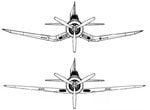davparlr
Senior Master Sergeant
I don't see this as an issue at all. True, it was a prototype, but it was a Navy prototype with a big wing and most likely carrier landing stress levels. It had four machine guns, probably .50s. I suspect that over a 1000 lbs could be removed from the prototype to make it AAF stress requirements and smaller wings. Contemporary Army aircraft had much lower empty weight, P-40C (which included armament, self sealing tanks and armor), 5812 lbs, P-36C, 4620 lbs, P-66, 5236 lbs. Adding 1500 lbs to the P-40C for engine and strengthening, and it comes to about 7300 lbs. True, these did have less armament, but that tended to be standard for the time. Also, the Fw-190A-3 had an empty weight of 6380 lbs, and the later F8F, with the R-2800 engine, had a empty weight of 7070 lbs. Now, unless the Germans had such advanced engineers that they could build a 6300 lb fighter with a big heavy radial where the American engineers could not, or it took Grumman engineers three years to figure out how to make a light weight fighter, the argument against a adequately protected and armed, fighter with an empty weight of around 7000 lbs seems unsupportable.you have a couple of problems with the comparison. The F4U prototype, if it actually carried guns, had one .30 and and one .50 in cowl and a single .50 in each wing. It was also a whole light lighter than service planes. In fact it comes just about the numbers you want. 7505 lbs empty, 9375lbs normal gross and 10,500 max take-off. It's fuselage was also about 3 ft shorter than the F4U-1. This is part of the difference between a plane with the single stage engine and one with the two stage and inter coolers. (Granted they also moved most of the fuel from wing tanks into the fuselage). The Prototype had no armor or self sealing tanks.
Engines are problematic. I do know the following. The B-26, with the R-2800-5, generating 1850 hp, but this seemed to be turbocharged. The XR-2800-4 seemed very capable. I do not know the maturity of design but it was soon replaced by the R-2800-8.The Prototype, being a prototype, was fitted with a least two different R-2800s, there seems to be a fair amount of confusion as to the exact configuration at times.
I just don't have much data at all on the Fw engine performance vs. altitude nor for the non-turbo R-2800.
Ammo is not part of empty weight and I don't want to go there. Four .50s were pretty standard as used in the P-51B and F4F-3, or some mixture with .30s.The guns and ammo for a P-40 (235rpg?) went 900lbs. The FW 190 guns went about 330lbs instead of 470 or so for six .50s and its ammo came up to about 430-330lbs or about the same as 1400 rounds of .50 cal ammo. Yjat is for 2000rounds of 7.9mm, 400 rounds of ammo for the Mg 151/20s and 120 rounds (+drums) for the MG/FFMs.
I think it would be quite a bit faster than the Spitfire V and the Bf-109F, and roughly equal to the Fw-190A1/2 and later 3 after upgrade to the -8.Neither the Spitfire or the Mustang were ever fitted with the 2 speed Merlin. It may make an interesting "what if". It does show that without a two stage supercharger the R-2800 fighter wasn't going to perform much better than what was already available.
While a long range escort fighter may not have been needed at the time the Spitfires barely had the range for what they were trying to do with them. It is one thing to cross the channel, it is another to make it past Paris, and yet even more just to make to the Rhine. Forget Berlin.
I am sure the P-40C and Spitfire were not great at that, either. I think the Brits were busy trying to keep Fw-190s off their tail.
Without knowing what the power profile of the early R-2800, can't argue anything.You also have the development problem, 6 two stage engines built in 1941, none in Dec 41 and Jan of 1942, and the 100th engine isn't delivered until some time in June. The "B" series single stage engine has 2 delivered in 1941 By P&W and and 2 by Ford, both are in the process of switching from "A" series to "B" series production, P&W delivers over 900 single stage "B"s in the first 3 months of 1942 and Ford delivers about 700 "A"s and 250 "B"s in those Months.

